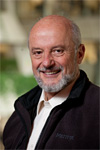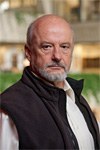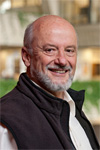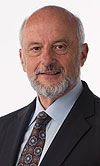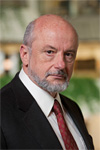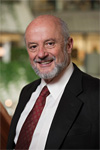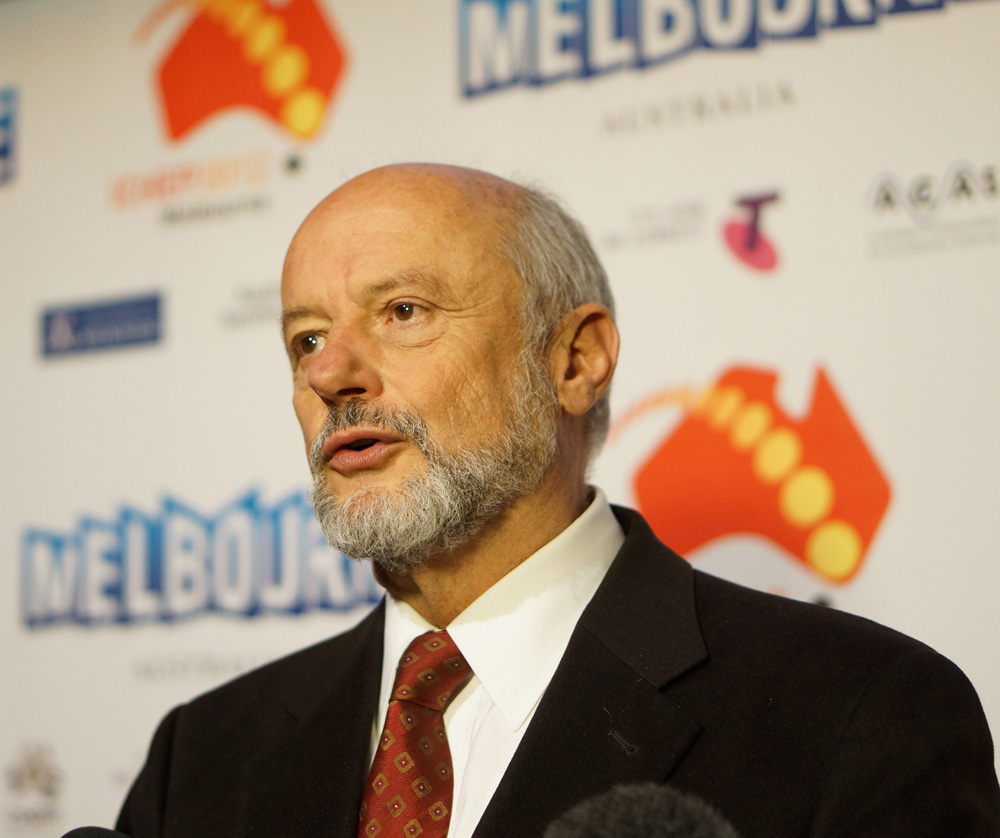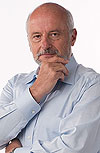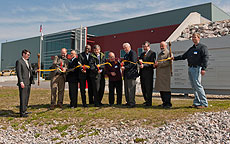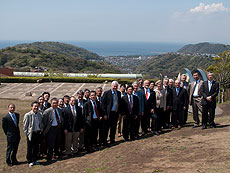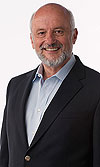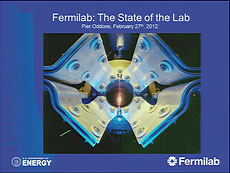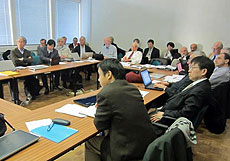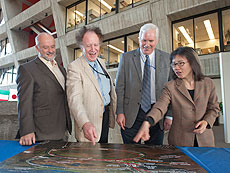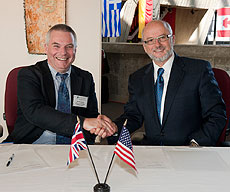|
Fermilab Director's Corner Archive |
| Subscribe | Contact Fermilab Today | Archive | Classifieds |
Every Tuesday, a new Fermilab Director's Corner appears in Fermilab Today, Fermilab's daily email publication for employees, users and subscribers.
Fermilab Director's Corner Archive – 2012
| December 18, 2012 |
| Happy holidays! |
|---|
|
I wish you and your family happy holidays. It has been a wonderful year for particle physics with the discovery of the Higgs-like particle at the LHC and the measurement of ?13 by the Daya Bay experiment in China, which opened the window for future neutrino experiments like LBNE. Our theorists are as happy as one can be figuring out what the Higgs might tell us and where the long-sought supersymmetry might be hiding.. At our own laboratory, we have had a trying year, but ultimately we accomplished what we needed to do to ensure a vital future for the laboratory. All the projects we started or that are under construction are going well: Mu2e, Muon g-2, NOvA, LBNE and MicroBooNE. NOvA is technically in good shape, if very tight on contingency. |
| December 11, 2012 |
| Master planning |
|---|
|
I've devoted many Director's Corners to the scientific vision for Fermilab, laying out the path toward a world-leading set of facilities at the Intensity Frontier. This path, which starts from our current facilities and neutrino experiments, goes through NOvA and the muon campus, and continues on to the Long-Baseline Neutrino Experiment and Project X, became even clearer yesterday with DOE's granting of CD-1 approval to the first phase of LBNE. But in order to meet our long-term scientific goals, we must also develop clear long-term goals for the development of the Fermilab site. This is the job of a new task force that has been established to develop a campus master plan. Such a plan will describe a set of guiding principles for the laboratory to follow as we imagine the future of Fermilab programmatically, functionally, aesthetically and environmentally. |
| December 04, 2012 |
| Organizational changes |
|---|
|
Several organizational changes went into effect this week at Fermilab and are now reflected in the organization chart for the laboratory. The changes are important but do not alter the fundamental structure of the laboratory. They are primarily in the supporting areas for laboratory planning, technology transfer, project management and international collaboration. The changes will help Fermilab to be more efficient and effective and will help to address the growing importance of international partnerships and the new programs at the Illinois Accelerator Research Center (IARC) with their associated need for managing technology transfer. They also help us with functions that we have been performing during the last few years in less than optimal ways. |
| November 28, 2012 |
| It can be done |
|---|
|
In today's competitive world, where the focus is often on the short term, conveying the excitement and value of particle physics to the public and policy makers is hugely important. But communicating particle physics to a lay audience is usually much more difficult for us scientists than giving a technical lecture in front of our colleagues. In our favor is the nature of the questions we tackle. They intrigue the public beyond many of the scientific questions that have a shorter time horizon. The Higgs-like particle discovered at the LHC this year generated an enormous amount of press worldwide and large crowds for Higgs-related scientific lectures and events. The nature of dark matter and dark energy, the world of neutrinos, the possible existence of hidden dimensions—all have a deep sense of mystery that appeals to a broad audience. But communicating these concepts without a lot of mathematics is quite a challenge. |
| November 13, 2012 |
| This week's FALC meeting |
|---|
|
The Funding Agencies for Large Colliders organization, known as FALC, was formed in 2003 with a different name—the Funding Agencies for the Linear Collider. One of FALC's early activities was to set up a common fund to support the Global Design Effort that would carry out the R&D and the design of the ILC. The L in FALC was generalized from "Linear" to "Large" a few years later. FALC is a voluntary organization set up by the agencies of the principal countries that support particle physics. It meets twice a year to discuss all issues relevant to the construction of very large global facilities. It has served to acquaint the senior managers of the various national agencies with their counterparts in other regions of the world, helping to build the trust necessary to someday embark on a large global facility. |
| November 07, 2012 |
| LBNE review at Fermilab and US-PRC meeting at Daya Bay |
|---|
|
Last week Fermilab hosted what would become a demonstration of valiant efforts of researchers and project reviewers alike, and what was perhaps the most important event at Fermilab last week—the successful Department of Energy CD-1 review of LBNE. We are very appreciative of the agency's and reviewers' efforts to hold the review despite the difficulties of travel due to the aftermath of hurricane Sandy. Several participants from the collaboration, DOE and the review committee rescheduled their flights to Fermilab to avoid the storm. Others had to join the meeting through the Web or by phone, including one LBNE spokesperson, who had to hand-crank a generator to keep his cell phone running. Participants in this successful CD-1 review acknowledged the enormous effort by the LBNE collaboration and the involvement of many members of the community to help the laboratory with the reconfiguration process. The review recommendation was for approval of CD-1, which hopefully will be granted by the DOE before the end of the year. This is a necessary milestone for the project. |
| October 30, 2012 |
| Staff meetings |
|---|
|
Over the last couple of weeks Young-Kee, Jack Anderson and I held seven meetings with our Fermilab colleagues. We hoped to meet with everyone in the laboratory in groups that fit in One West so that we could have more thorough discussions than are usually possible in the larger Ramsey Auditorium all-hands meetings. We held these meetings for the first time last fall, and they received positive feedback. This time around, the Employee Advisory Group advised us that lab staff would profit from a more thorough discussion of Fermilab's scientific projects and programs following our transition from the Tevatron, of the safety performance over the last fiscal year and on communication and management issues at the laboratory. |
| October 23, 2012 |
| PAC and new ideas |
|---|
|
We are very fortunate to have a great Physics Advisory Committee comprising distinguished scientists from the national and international particle physics community. Over the last several years the PAC has helped Fermilab establish an exciting suite of future experiments. Although this set of experiments uses all of the financial resources currently available to us, the flow of ideas has not stopped, and our creative user community continues to propose very attractive experiments using our current and future facilities. For example, past PAC meetings have analyzed proposals for the ORKA experiment to measure kaon decay, the LAr1 experiment to study short-baseline neutrino anomalies, and the nuSTORM project to create an on-site muon ring to study neutrino cross sections and anomalies in unprecedented detail. |
| October 16, 2012 |
| 45 years young |
|---|
|
This year marks the 45th anniversary of Fermilab, established by the Atomic Energy Commission in November 1967. In the four-and-a-half decades since its founding, Fermilab has been on a remarkable trajectory of major discoveries and technological advances. From the very beginning and throughout its history, Fermilab devoted itself to scientific discovery in an atmosphere of equality and opportunity for our staff and users while being a responsible steward of our extraordinary natural environment. The sense of the frontier has permeated not only our expanding science program, through which we constantly open new territory, but also our surroundings, with the magnificent restored prairie and our American bison herd. In recent years the bison have come to symbolize for me not only the frontier, but also how tough we are as a laboratory. |
| October 09, 2012 |
| 2012 Community Planning Meeting |
|---|
|
From Thursday through Saturday this week we will welcome many of our colleagues from across the country to Fermilab for the 2012 Community Planning Meeting (CPM2012), organized by the Division of Particles and Fields of the American Physical Society. This meeting is the first preparatory meeting for next year's extensive Community Summer Study, where we will develop and articulate the opportunities for particle physics for the long-term future. CPM2012 follows the successful organization of DOE's 2011 Intensity Frontier workshop. The summer of 2013 is an ideal time to take stock of all the physics we will have learned in the previous couple of years, especially with the tremendous flow of new data from the LHC, including the discovery of the Higgs-like particle at 125 GeV and the important new measurements of neutrino oscillations by reactor and beam-based experiments, which have confirmed the highest hopes for neutrino physics. |
| September 25, 2012 |
| Success! |
|---|
|
"First light" for any telescope or astronomical instrument is a moment of great excitement, one in which everything comes together for the first time – telescope, instrument and sky. It is a very special moment both for the people who design and build the instrument and for the astronomy community. Having spent years planning DECam's design and overseeing the camera's construction, the Dark Energy Survey collaboration was able to show the world magnificent images right out of the gate. DECam achieved first light on Sept. 12, and very quickly it began producing high-resolution images of far-away galaxies. Later this year, after commissioning the instrument and verifying its performance, the DES collaboration will begin collecting data using different types of observations to understand the nature of dark energy, the mysterious force that is accelerating the expansion of our universe. |
| September 18, 2012 |
| Update on tritium management at Fermilab |
|---|
|
Next year, with the restart of our accelerator complex, Fermilab is poised to enter a new era of experiments with high-intensity particle beams. To prepare for this new era, we are upgrading and improving the accelerator complex and building new particle detectors. But with higher-intensity beams will also come an increase in the production of tritium, and we are preparing for that as well. Tritium, a weakly radioactive isotope of hydrogen, is a normal byproduct of accelerator operations here at Fermilab. Very small but detectable levels of tritium are found in some of the ponds on our site, in Indian Creek, which flows to a pond in the Savannah community off site, and in sanitary sewer water that is pumped to a wastewater treatment facility in Batavia. These levels are well below regulatory standards that Fermilab is required to meet. |
| September 14, 2012 |
| Involuntary separation |
|---|
|
Today, the final phase of the workforce reduction announced in May is taking place. This involuntary phase affects 22 employees across the lab. It follows the voluntary separation that occurred in June, when Fermilab management was able to accept 27 individuals who applied for the program. When I originally announced that a workforce reduction would be necessary due to reduced federal funding, we anticipated that approximately 80 employees would be affected. Because of attrition over the past few months, we were able to significantly reduce the number of involuntarily separated employees. |
| September 11, 2012 |
| Science and technology review |
|---|
|
Last week we had a three-day science and technology review of laboratory operations. The DOE S&T Review is one of the principal yearly reviews of the laboratory and has a very wide scope, including evaluations of: the quality and significance of recent S&T accomplishments and the merit and feasibility of future plans to maximize scientific opportunities the effectiveness and efficiency of facility operations and of the planning for future facility upgrades the effectiveness of laboratory management in strategic planning, developing core competencies, setting priorities and promoting a culture of safety |
| September 04, 2012 |
| Culture clash |
|---|
|
At the recent meeting of the Employee Advisory Group, we discussed some of the results of the recent safety survey. One of the concerns arising from the survey was that employees often feel they have too many tasks and not enough time to do them. This can lead to distraction and, consequently, to employees' performing their tasks unsafely, especially if employees are buffeted by multiple demands and take shortcuts to complete multiple jobs. Performing multiple tasks and completing them safely should not be mutually exclusive goals. At our lab, however, there is a strong culture to get things done no matter how tough the circumstances are. This "can do no matter what" attitude at Fermilab is wonderful and it serves us well in many instances. However, if it leads to distractions, too-long working hours or shortcuts in matters of safety, it will serve us very poorly. |
| August 29, 2012 |
| This week's HEPAP meeting |
|---|
|
During the last two days, I attended the meeting of the High Energy Physics Advisory Panel in Washington, DC. This was the first HEPAP meeting after the Long-Baseline Neutrino Experiment was reconfigured to comply with DOE's financial guidelines. The discovery by the Daya Bay reactor experiment of a large theta-13 parameter in neutrino mixing, just a few days before the previous HEPAP meeting in March, has opened the gate for important future advances in neutrino physics and removed the major risk for LBNE. The afternoon of the first day was devoted entirely to the topic of LBNE. Stephen Parke began the discussion with a talk on the physics of neutrinos, and Deputy Director Young-Kee Kim followed with a comprehensive report on the effort she led to reconfigure LBNE into a phased program. |
| August 21, 2012 |
| Laboratory-wide survey on ES&H culture |
|---|
|
In April, the ES&H Section distributed a survey on laboratory safety culture to Fermilab employees. I have reviewed the results of this important survey and wish to share them with you. I am very pleased to report that survey participation was nearly 70 percent, a very high response for a survey done on a voluntary basis. I want to thank you for your participation. The roughly 50 questions covered the gamut of Fermilab's safety issues. Given the good response rate, the survey provides us with an overall view of where we are in ES&H and where we need to focus our future efforts. In addition, DOE encouraged its laboratories to conduct their own surveys so that we could benchmark ourselves and determine what is working and what is not. (We will receive those benchmarking results in the fall.) |
| August 07, 2012 |
| Shutdown progress |
|---|
|
In May of this year we began a major shutdown of our accelerators that will last almost a full year. During this shutdown we will upgrade the Main Injector ring, the NuMI beam line and target, the Recycler ring and the Linac. This will bring the accelerator complex to its "NOvA-era configuration," delivering 700 kilowatts of beam power to NOvA while running other experiments off the Booster ring and providing test beams to the Meson Lab. The work is ahead of schedule, and in this week's column I want to thank the many employees from across the laboratory who have come together to make such great progress over the past three months. The word shutdown is misleading – rather than a time of slow activity it is probably the busiest time ever for many staff members. |
| August 02, 2012 |
| A transition |
|---|
|
I write today to let you know that I will retire on July 1, 2013, at the completion of my eighth year as director of this great laboratory. I have asked Fermi Research Alliance to begin the selection process for the next director. As long as I remain director, I will continue my utmost efforts to deliver value for the investments made in Fermilab and to keep our laboratory and the national particle physics community at the forefront of the global quest to discover the fundamental nature of the physical universe. |
| July 31, 2012 |
| Update on SRF and NML |
|---|
|
The development of the superconducting 1.3-GHz radio-frequency test facility at NML, which would comprise three cryomodules and an electron beam to test them, suffered a setback earlier this year with the zeroing out of funds for the International Linear Collider. The U.S. ILC R&D program will end in June 2013 when the worldwide Global Design Effort completes their technical design report and thus its mission. As I explain in more detail below, while NML will continue to operate as a cryomodule test facility despite the zeroing out of ILC funds, it can also support a broader program in advanced accelerator R&D. The laboratory is committed to pursuing all avenues that will allow us to complete this program. |
| July 24, 2012 |
| Zero defects |
|---|
|
On Tuesday, I took part in a meeting that included DOE Office of Science leaders and laboratory directors. Discussion topics ranged from the remarkable programs that the Office of Science supports, including scientific research and facilities, to non-scientific subjects such as safety. Certain lab directors shared particular concerns because some close calls have happened across the laboratory complex. Office of Science Director Brinkman suggested that, rather than emphasizing the concept of "zero accidents," we should instead emphasize "zero defects." I like this emphasis for our laboratory because it can be embedded in a larger framework. |
| July 17, 2012 |
| ICFA and ILCSC in Melbourne |
|---|
|
The International Linear Collider Steering Committee and the International Committee for Future Accelerators met recently in Melbourne in conjunction with ICHEP2012. Joining us was Lyn Evans, who in June was appointed to be the Linear Collider Director. In this column I briefly summarize the situation with the ILC and the new organization that brings together the ILC and CLIC efforts. More information can be found in my presentation to ICHEP attendees. The linear collider effort has received a big boost with the discovery at CERN of a particle likely to be the Higgs boson. |
| July 10, 2012 |
| A path forward for LBNE |
|---|
|
DOE Office of Science Director Bill Brinkman has written me a letter supporting the reconfiguration of LBNE and requesting us to proceed to CD-1. The CD-1 review will take place at the end of October, followed by the formal approval of CD-1 towards the end of this calendar year. We appreciate very much the strong support of the Office of Science for the directions established by the 2008 HEPAP Particle Physics Project Prioritization Panel (P5). The P5's plan along the three frontiers, including a leadership role for the United States at the Intensity Frontier, has been well received beyond the DOE. Stabilizing the LBNE situation now with a viable and affordable option will make it possible to explain our path forward to Congress and the White House's Office of Management and Budget and to obtain their support for FY13 and beyond. |
| July 05, 2012 |
| A great discovery |
|---|
|
The announcement on July 4th by CMS and ATLAS that they have discovered a new particle likely to be the long-sought Higgs boson has reverberated around the world. As well it should. It is of fundamental importance to our understanding of nature and it opens new paths towards a more complete understanding of the physical laws that rule our existence. In this short column I want to congratulate CERN and the many collaborators around the world that have brought us this discovery. I want to congratulate and thank especially all the people at Fermilab who contributed to this discovery; the CMS collaboration members who have been involved in the analysis of the data; the scientists and staff members who support more than fifty US universities in their LHC participation; the many physicists, engineers and technicians who contributed to the building and operation of CMS; the computer specialists who have made the grid software successful; the folks who helped build the LHC's final-focus magnets, the most complex in the accelerator; the specialists who contributed to the repair of the LHC after its rocky start; the administrators who have supported the many folks working on LHC for more than a decade, going back and forth to CERN; and especially all the collaborators at the Tevatron who pioneered many of the accelerator and detector technologies, triggering systems and analysis techniques that have contributed mightily to the success of the LHC. |
| July 03, 2012 |
| Great expectations |
|---|
|
I arrived in Australia a couple of days before the start of the International Conference on High Energy Physics to find articles in the newspapers predicting a "Big Bang" on July 4 when the latest Higgs results from the LHC will be presented at CERN. I and my fellow ICHEP attendees will watch the joint CMS and ATLAS seminar via a webcast. Many scientists will gather at Fermilab at 2 a.m. to watch the same webcast and start their Independence Day celebrations very, very early. There is great anticipation here at Melbourne, at Fermilab and across the world for what will be revealed this week. Yesterday we presented the final Tevatron's Higgs search results. |
| June 26, 2012 |
| The Physics Advisory Committee |
|---|
|
The June retreat with our Physics Advisory Committee took place last Tuesday through Saturday. In these yearly meetings the PAC, laboratory leadership and representatives from DOE and NSF get together for a detailed review of the laboratory's program and plans for the future. It is an intense retreat with long hours of presentations and discussions and numerous writing assignments. We also hear presentations on new ideas that are submitted through letters of intent and formal proposals. This year we discussed three letters of intent and one proposal, a clear sign that the creativity of our community continues unabated. |
| June 20, 2012 |
| ICFA appoints Lyn Evans as first Linear Collider Director |
|---|
|
At its February meeting earlier this year, the International Committee on Future Accelerators agreed that the world's undertakings to build a linear collider would benefit from a reorganization. For the last couple of years the Global Design Effort, which runs the International Linear Collider program, and the Compact Linear Collider organization have been collaborating on issues that are common to both efforts, such as damping rings, positron sources, conventional facilities, final-focus systems, detector configurations and costing studies. ICFA concluded it was time to proceed with a new organization that would unify both efforts. ICFA has now taken the next significant step toward unification. It has appointed CERN's Lyn Evans to be the overall leader for the combined linear collider programs. |
| June 12, 2012 |
| A great day at Fermilab |
|---|
|
Yesterday's Tevatron Impact symposium was a very special event. It was extraordinary to hear in one afternoon reviews of the impact of the Tevatron on our understanding of fundamental physics; on the development of accelerator technology that has influenced every subsequent major hadron accelerator; on the detector technologies and trigger systems that are essential today for high-luminosity machines like the LHC; on the multivariate analysis techniques that now allow us to squeeze the maximum information from complex data sets; on societal and economic impact through the roughly 1,500 Ph.Ds who trained at the Tevatron; on the superconducting-wire industry that made MRI magnets ubiquitous; and on the major computational systems using large farms of Linux-based commodity processors. |
| June 05, 2012 |
| Planning is everything |
|---|
|
Once a year each of the Office of Science laboratories present their plans for the future to Director Bill Brinkman, Pat Dehmer, the associate directors of the six Office of Science programs and additional DOE staff experts. In many ways Fermilab, as a single-program laboratory, has a simpler presentation to make than some of the other labs: we only have to present a compelling program in particle physics. In other ways our presentation is much more complex. We depend entirely on the health of one program that requires major investments during this time of fiscal austerity. We must convince our important audience that these investments in particle physics pay off, even when measured in comparison with other scientific priorities. |
| May 29, 2012 |
| Join the Tevatron celebration |
|---|
|
Since I am on vacation this week, I thought I would use the Director's Corner to invite all of you — employees, users and students — to join me at Tevatron Impact, the June 11 symposium that will celebrate the Tevatron's many achievements and the future of our laboratory. Many of our long-standing collaborators from across the country and around the world are coming to the symposium, as well as many representatives of the national and international funding agencies that have supported the Tevatron during its long life. There is an impressive line-up of speakers, including keynote speaker Lisa Randall from Harvard University, CERN Director-General Rolf Heuer, John Womersley who is now the CEO of the UK's Science and Technology Facilities Council, and a number of notable figures from the Tevatron's history. |
| May 22, 2012 |
| SNOLAB inauguration |
|---|
|
Last week I attended the inauguration of SNOLAB. This underground facility in Ontario, Canada has been used now for more than two decades, starting with the enormously successful Sudbury Neutrino Observatory. SNO was a daring experiment that borrowed several hundred tons of extremely valuable heavy water from the Canadian nuclear establishment and resulted in the most precise understanding of neutrinos from the sun. Over the years additional experiments joined SNO to take advantage of the deep underground location. In the last few years the underground facilities have been expanded with several large caverns and experiments, resulting in the world's deepest, largest clean-area laboratory. |
| May 15, 2012 |
| Kudos to our award winners |
|---|
|
Last week the Department of Energy announced the Early Career Award recipients for 2012, and I am pleased to congratulate our four winners: Brendan Casey, Tengming Shen, Pavel Snopok and Sam Zeller. The awards are highly competitive with only 68 awards granted out of more than 800 peer-reviewed proposals. Over the last couple of years we have encouraged our young investigators to compete for these awards. This great program encourages and rewards outstanding scientists early in their careers and gives them the flexibility to explore new directions in their research. Recipients typically receive $500,000 per year for five years to cover salary and research expenses. Ours is mostly a team science, with credit and funding shared by many scientists working on a given program or project under strong leaders and as a result there are few avenues for young investigators to strike in new directions on their own. |
| May 08, 2012 |
| Attention to safety |
|---|
|
The shutdown has begun, and with it comes an enormous amount of work to upgrade our accelerators and build the detectors for our new projects. Today I want to remind you to be ever vigilant regarding your safety. This applies to all work activities, but especially to the large mechanical installations such as the Main Injector and the NOvA detector, which are not routine and can lead to serious injuries if you do not pay attention. I normally would not feel the need to call attention to this matter, trusting the strong safety culture at Fermilab. However, this year's numbers for recordable cases and for days away and restricted are the worst we have had in the last several years. Is this a sign that we are relaxing our attention to safety? These injuries were accumulated over the last several months, before the start of the shutdown, and naturally raise concerns that we are not doing enough to ensure the persistent awareness necessary for us to stay safe at all times. |
| May 04, 2012 |
| Special Director's Corner: Workforce reduction |
|---|
|
Yesterday I announced to Fermilab employees a self-select voluntary separation program to bring our staffing levels into balance with funding expected for the next few years. This is not a step that I am taking lightly, and it is a last resort after we have significantly reduced spending in many other areas. Prospects for the lab's future funding look better than they did in February, thanks to recent Congressional actions. These actions by the House and Senate restored some funding to our budget for the next fiscal year, which allows us to minimize the size of the workforce reduction. We still expect to receive an overall reduction starting Oct. 1, however, and anticipate that tight budgets will continue as the federal government continues to confront large budget deficits. |
| May 01, 2012 |
| Inauguration of the NOvA facility in Ash River, Minn. |
|---|
|
On April 27, more than 250 people gathered to inaugurate the NOvA facility near the Ash River in northern Minnesota. The facility consists of the huge far detector building, building fixtures and the impressive lifter that will position the NOvA blocks in their vertical position. When standing in the hall where the detector will be built, the building looks astonishingly large: it almost seems impossible that one day soon almost every square foot will be filled with detector. |
| Apr. 24, 2012 |
| U.S./Japan meeting |
|---|
|
This week we have something to celebrate: Friday's inauguration of the facilities near Ash River, Minn., where NOvA will operate starting in 2014 and continue at least through the early 2020s. The facility is ready for the construction of the detector, which will use the massive block pivoter developed and tested at Fermilab to rotate and position 200-ton detector blocks. It will be exciting to see the 15,000-ton detector in Minnesota come together over the next year in parallel with our work here at Fermilab to upgrade the accelerator complex and construct NOvA's near detector cavern. With NOvA, we have an extremely powerful program ahead of us. Another important event taking place this week is the workshop on LBNE options taking place on April 25 and 26. |
| Apr. 17, 2012 |
| FALC meeting |
|---|
|
The Funding Agencies for Large Colliders meeting took place this week in Shonan Village, Japan. I presented the Fermilab program and reported on the activities of International Committee on Future Accelerators. FALC brings together representatives from the principal countries supporting particle physics. The funding agencies present this year hailed from the countries of Japan, Korea, China, the United States, Canada, the United Kingdom, Italy, Germany, France and Spain. The meeting featured presentations from the various world regions and discussions of the future organization of major global projects, such as the ILC. The reports from Europe described great stability in their plans for the future, despite the European financial crisis. |
| Apr. 10, 2012 |
| Our plan for discovery |
|---|
|
When I returned from a trip to Europe some months ago, the officer stamping passports at O'Hare looked at my address, which is on the Fermilab site, and mentioned that it was too bad I would lose my home since Fermilab was shutting down. It gave me an opportunity to let him know that we are very much alive and kicking and that the Tevatron closure was not the closure of Fermilab. It was, however, a reminder that many members of the public believe that Fermilab is shutting down now that the Tevatron is no longer running. The particle physics community knows this isn't the case, but we must communicate our future plans to a broad audience. |
| Apr. 03, 2012 |
| Long-Baseline Neutrino Experiment |
|---|
|
We have started a vigorous effort to answer Office of Science Director Bill Brinkman's charge to Fermilab to find a path forward to reach the goals of the Long-Baseline Neutrino Experiment in a phased approach. A steering committee led by Deputy Director Young-Kee Kim, with many of the LBNE stakeholders as members, will guide the study. The steering committee will have two working groups: the physics working group, led by Mel Shochet of the University of Chicago, and the engineering/cost working group, led by Mark Reichanadter of SLAC. The steering committee will provide guidance to the working groups and will ultimately write the report for DOE. The physics working group will analyze the physics reach of the various phases and alternatives on a common basis. |
| Mar. 27, 2012 |
| Independent laboratory-wide survey on ES&H culture |
|---|
|
I would like us to participate on an independent survey on ES&H culture. For the survey to be effective as a learning tool for our laboratory, I am encouraging everyone to participate. The survey is done by the Indiana University of Pennsylvania Department of Safety Science, funded by the Alcoa Foundation. The DOE has encouraged all its laboratories to participate. Workplace surveys such as the one we want to participate in are designed to hear from everyone in the workforce. They empower the workforce to provide input in order to make the most robust and safe program possible. While individuals taking the survey will remain anonymous, the results of the survey (i.e. collective responses) will be used to give us a picture of where we are both at the lab as a whole and in Divisions/Sections/Centers. |
| Mar. 23, 2012 |
| DOE decision on LBNE |
|---|
|
Yesterday I received a letter from Office of Science Director Bill Brinkman in which he describes the DOE decision regarding the future of the Long-Baseline Neutrino Experiment. DOE has decided that it cannot support the LBNE project in its current form in the current budget climate. The Office of Science remains very supportive of the experiment's scientific goals, however, and has charged Fermilab with investigating options for achieving these goals that fit within the more restrictive budgets predicted in future years. Fermilab and the LBNE project team and collaboration remain committed to achieving these goals, which have broad support from the scientific community. We will work closely with DOE and the particle physics community over the coming months to outline options for a phased approach to the long-baseline neutrino experiments as per Dr. Brinkman's request: |
| Mar. 20, 2012 |
| High Energy Physics Advisory Panel meeting overview |
|---|
|
The High Energy Physics Advisory Panel met early last week, and several important topics were on the agenda, notably the FY13 budget request, planning for the future of our field and comparative reviews for DOE grants. HEPAP gives advice to both DOE and NSF on the national particle physics program, and last week's meeting included reports from Office of Science Director Bill Brinkman, Jim Siegrist from the DOE Office of High Energy Physics and NSF. The DOE reports acknowledged that the three lower-priority programs in the Office of Science - nuclear physics, particle physics and fusion - are under a lot of budgetary stress. In particle physics, the stress is concentrated at Fermilab since the President's budget request limits our large international projects. DOE will report its plans to Congress on one such project, the Long-Baseline Neutrino Experiment, by the beginning of April. |
| Mar. 13, 2012 |
| An important scientific result |
|---|
|
I must begin on a somber note, as this week we are completing the previous reduction in force program that had not been applied to the computing sector last year due to that sector's ongoing restructuring. Involuntary separations due to budget issues are very painful and we very much regret the loss of each employee. We have no choice, however, when the budgets do not maintain our desired staffing level. Now, to news that is much more positive for our future neutrino program. Last week, the Daya Bay Reactor Neutrino Experiment reported the first definitive results on the rate at which muon neutrinos convert to electron neutrinos. |
| Mar. 06, 2012 |
| The Employee Advisory Group |
|---|
|
We are seeking nominations for eight new members of the Employee Advisory Group. The EAG is very valuable to me and other managers at the laboratory in helping us understand the many issues related to our work environment and how to improve that environment through policy development. If you have insights, concerns and suggestions about Fermilab policies and programs that affect your workplace I encourage you to consider nominating yourself or a colleague that shares the same interest. The deadline for nominations is March 16. The EAG is a direct pipeline from the many levels of the work environment to senior managers. The committee meets approximately once a month. |
| Feb. 28, 2012 |
| All-hands meeting video |
|---|
|
On Feb. 27, Fermilab Director Pier Oddone led an all-hands meeting to discuss the current state of the laboratory. The talk is available in the online archive. The presentation slides are also available online. |
| Feb. 21, 2012 |
| On the positive side... |
|---|
|
Last week I described the cuts to the laboratory budget proposed for FY13 that would make our life quite difficult if they are enacted. This week I want to focus on the positives: our program is supported in the President's Budget Request (PBR) and we are on track for an exciting near-term research program. However, the long-term program remains under pressure. With enormous emphasis placed, in this election season, on reducing the deficit and getting the country's finances in order, turbulent times are ahead and our future plans have to take into account this uncertainty. As always, we will continue to do our best to give maximum value for the support we receive. So what's in store for our near-term program? In May our accelerator complex will shut down to complete upgrades of the Main Injector for the NOvA program. Beams will return in FY13, delivering neutrinos to the MINOS+, MINERvA and NOvA experiments. |
| Feb. 14, 2012 |
| President's Budget Request |
|---|
|
The President's Budget Request (PBR) for fiscal year 2013 was unveiled yesterday. In this Director's Corner, I describe for you what I know at this time in the spirit that I have maintained throughout this column: to share with you the good, the bad and the ugly. I remind you that there is a long time before a FY13 budget is enacted by Congress, and in that time many things can change. In the meantime we have a lot of planning to do. The PBR reduces funding for the DOE Office of High Energy Physics by 1.8 percent from the current level. The cuts applied to Fermilab, however, are significantly greater: about $30 million or 8 percent. This budget will be very hard to manage as we transition to our new programs. |
| Feb. 07, 2012 |
| ILCSC and ICFA meetings |
|---|
|
Last week, the meetings for the International Linear Collider Steering Committee and the International Committee for Future Accelerators took place in Oxford, England. This was my first meeting as chair of ICFA, succeeding KEK Director Atsuto Suzuki. One of the principal issues discussed at both meetings was a new organization for the worldwide linear collider effort. For some time now, the world's two large linear collider efforts – the ILC Global Design Effort and CLIC, the Compact Linear Collider - have been working on common issues applicable to both colliders. As we move into the next phase in the evolution of linear colliders it is important to bring the ILC and CLIC efforts under unified leadership. |
| Jan. 31, 2012 |
| URA Council of Presidents |
|---|
|
The Universities Research Association's Council of Presidents took place on Jan. 25 in Washington DC. This yearly business meeting brought together the presidents of URA institutions or their representatives. At this meeting, I presented a report on the status of Fermilab. It was an opportunity for our laboratory to present our programs and plans and generate enthusiasm and support from senior university leaders. The Council meeting also featured presentations by and discussions with policy makers. |
| Jan. 24, 2012 |
| Next step for the Long-Baseline Neutrino Experiment |
|---|
|
The LBNE collaboration is now quite a formidable enterprise with over 300 collaborators from more than 60 institutions including six national laboratories, and it is growing. The project is very ambitious with a program to reach unprecedented sensitivity and precision for addressing the neutrino mass hierarchy, CP violation in neutrino mixing, the value of the mixing parameters including precision measurement of ?13. While the primary goal of LBNE is to study neutrino oscillations it will also provide new capabilities to search for nucleon decay, observe neutrinos emitted by supernovae in our galaxy and beyond, and address other important topics in physics and astrophysics. |
| Jan. 17, 2012 |
| Proton Accelerators for Science and Innovation |
|---|
|
Last week we hosted the US-UK Workshop on Proton Accelerators for Science and Innovation. The workshop brought together scientists from the United States and the United Kingdom who are working on high-intensity proton accelerators across a variety of fronts. The meeting included not only the developers of high-intensity accelerators but also the experimental users and those involved in the applications of such accelerators beyond particle physics. At the end of the conference, John Womersly, CEO of the UK's Science and Technology Facilities Council, and I signed a letter of intent specifying the joint goals and activities of our collaboration for the next five years. We plan to have another workshop in about a year to review progress and explore additional areas of collaboration. |
| Jan. 10, 2012 |
| Leveraging technologies |
|---|
|
When the International Linear Collider's international committee selected superconducting RF technology for the ILC in 2005, one of the motivations for the decision was the potential utility of SRF technology for other fields of science and for even broader applications. That decision has already proved beneficial in planning the next generation of facilities in the United States. Here at Fermilab, we have leveraged the investment in ILC technology to develop the skills and facilities necessary to build Project X. While the accelerating gradients to be used in Project X are lower than the ILC gradients, similar challenges exist in building very high-quality cavities with low losses. |
| Jan. 03, 2012 |
| The new year |
|---|
|
We have a mountain of exciting work coming our way! In accelerator operations, we need to give enough neutrinos to MINERvA to complete their low-energy run, enough anti-neutrinos to MiniBooNE to complete their run and enough neutrinos to MINOS to enable their independent neutrino velocity measurement that will follow up on last year’s OPERA results. We need to provide test beams to several technology development projects and overcome setbacks due to an aging infrastructure to deliver beam to the SeaQuest nuclear physics experiment. And we need to do all of this in the first few months of the year before a year-long shutdown starts. During the shutdown, we will modify the accelerator complex for the NOvA era and begin the campaign to double the number of protons from the Booster to deliver simultaneous beams to various experiments. |
Director's Corner - Current Archive
2014 Director's Corner Archive
2013 Director's Corner Archive
2012 Director's Corner Archive
2011 Director's Corner Archive
2010 Director's Corner Archive
2009 Director's Corner Archive
Return to Current Fermilab Today
